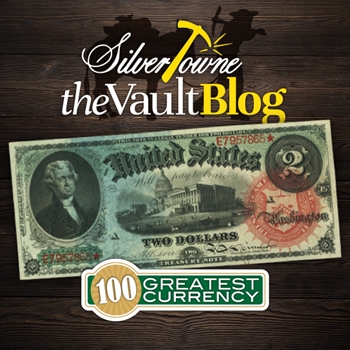
Our next entry in the 100 Greatest American Currency Notes blog series features one of many in the “Rainbow Notes.” Along with authors Q. David Bowers and David M. Sundman, we will delve deeper into what makes this particular note appear on such a list published by Whitman Publishing.
#40 - Series of 1869 $2 Legal Tender “Rainbow Note”
One of many denominations among the “Rainbow Notes,” the Series 1869 $2 note features the portrait of Thomas Jefferson to the left of the United States Capitol. The building itself has been depicted numerous times on the faces of notes state-chartered and federal with some early features showing the building without the dome finished. The name “Rainbow Note” derives from the array of colors on the face with a blue tint on part of the paper, a red Treasury seal, and green in the background by the serial number and across the top. For this $2 Rainbow Note, over 24.7 million were printed. However, only 1,500-2,500 are known to still exist within the market. They are slightly more rare than the $1 note from the same series.
What also makes this note unique is that Jefferson made his debut on the $2 note. The Jefferson era of politics brought in a concept of government that was composed of representatives of separate political parties. His “Democratic Republicans” were the first to challenge Federalist candidates and would help his victory in the election of 1800. He helped realize and legitimize the idea of a challenger in American politics. His successes spoke for themselves and made it apparent why he was featured on the face of American currency notes.
The face of the “Rainbow Deuce” was created by a few gentlemen. Charles Burt, an Edinburgh Scot, created the Jefferson portrait while serving as one of the chief engravers for the Treasury Department. The Capitol scene was engraved by Louis Delnoce and William Chorlton. The face and the back bear the imprint of the American Bank Note, Co., New York.
In 1960, the historic market value for this note in Gem Crisp Uncirculated condition was $200. By this publication in 2006, that same note rose to $8,000.







